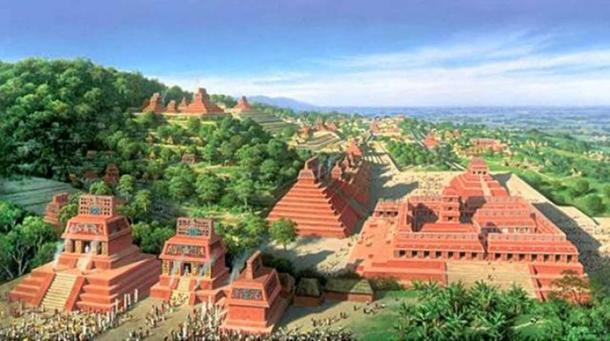
Laser Scans Reveal 60,000 Previously Unknown Maya Structures Hidden in Guatemalan Jungle!
In a monumental archaeological discovery, whose magnitude hasn’t been seen in decades, an aerial survey over northern Guatemala revealed tens of thousands of Maya structures, including pyramids, palaces, temples, fortifications, highways, houses, and farms, which had been hidden for centuries amidst the thick vegetation of the Guatemalan jungle. This incredible discovery indicates that the Mayas had an enormous, interconnected network of ancient cities, which revised estimates now say may have been home to as many as 7 to 11 million people some 1,200 years ago.
Archaeologists are Hitting the Ground Running
In February, National Geographic exclusively revealed that the previously unknown ancient structures were spotted using LiDAR (“Light Detection and Ranging”) technology, which can ‘see through’ the jungle canopy to identify monuments below. The aerial scanning technique is revolutionizing the field of archaeology as it quickly reveals man-made sites, which would be near impossible to discover through ground searches due to the dense vegetation and harsh conditions of the jungles of Central and South America.
Now the full study from Tulane University has been published in Science magazine and confirms the extent of the Maya civilization in the region.
Francisco Estrada-Belli, a researcher from Tulane commented:
“Seen as a whole, terraces and irrigation channels, reservoirs, fortifications and causeways reveal an astonishing amount of land modification done by the Maya over their entire landscape on a scale previously unimaginable.”
In a statement, Marcello Canuto, director of the Middle American Research Institute at Tulane listed some of the highlights, including 61,480 ancient structures in the survey region; an estimated population of 7-11 million; 362 square kilometers of terraces or otherwise modified agricultural terrain and another 952 square kilometers of viable farmland; 106 square kilometers of causeways within and between urban centers.

An earlier LIDAR scan that revealed a network of roads, canals, corrals, pyramids, and terraces at El Mirador. Credit: Archaeological Project Cuenca Mirador.
“LiDAR is revolutionizing archaeology the way the Hubble Space Telescope revolutionized astronomy,” said Francisco Estrada-Belli, a Tulane University archaeologist and National Geographic Explorer [via National Geographic]. “We’ll need 100 years to go through all [the data] and really understand what we’re seeing.”
Now that the location of tens of thousands of monuments have been identified, archaeologists are hitting the ground running to begin excavations and explorations of some of the sites.
- Oldest Royal Tomb of the Classic Maya Centipede Dynasty is Unearthed in Guatemala
- 2,000-Year-Old Maya Superhighway Discovered in the Jungle of Guatemala
- Remarkable Secret Tombs of Maya Snake Kings Reveal Fascinating Story
Enormous ‘Megalopolis’ Revealed
The project mapped a 2,100 square kilometre (800 square mile) area around the popular tourist site of Tikal in the Petén region of Guatemala. The results of the aerial survey, which produced a series of 3D images of the landscape below the jungle canopy, revealed an enormous network of cities, which is being hailed as a ‘megalopolis’.
The images showed over 60,000 previously unknown structures, including complex agricultural systems with canals, dikes, and reservoirs for irrigation, and terracing for supporting food production for the masses. Also discovered was a huge highway network – raised to prevent flooding issues in the rainy season – which connected the cities and quarries, and had been constructed by hand, without the use of the wheel or ‘beasts of burden’.
The interconnected network of ancient Maya cities was home to millions more people than previously thought https://t.co/0E0FafOyRR
— National Geographic (@NatGeo) February 1, 2018
Another surprising finding was the sheer scale of the defensive structures, including walls, ramparts, terraces and fortresses, which indicate that warfare was happening on a much larger-scale than previously realized.
“Warfare wasn’t only happening toward the end of the civilization,” said Thomas Garrison, an Ithaca College archaeologist and National Geographic Explorer. “It was large-scale and systematic, and it endured over many years.” [via National Geographic].
Population Estimates Dramatically Revised
One of the implications of the discovery is that archaeologists must now revise their estimates of the size and extent of the Maya civilization.
“The results suggest that Central America supported an advanced civilization that was, at its peak some 1,200 years ago, more comparable to sophisticated cultures such as ancient Greece or China than to the scattered and sparsely populated city states that ground-based research had long suggested,” reports National Geographic.
More generous population estimates had been around the 5 million mark, but the recent finding suggests that 7-11 million people had been living in the jungle cities at the peak of the Maya civilization Late Classic Period (approximately 250 – 900 AD).
- Archaeologists discover Royal Maya Burial at El Zotz Ruins in Guatemala
- The Stone Head of Guatemala that History Wants to Forget
- Mayan Child Sacrifices with ‘Divine’ Obsidian and Jade Discovered in Guatemala

Artist’s representation of what the Maya world may have once looked like (artist unknown)
This is Only the Beginning
The survey is just the first stage of a project spearheaded by the PACUNAM Foundation, a Guatemalan non-profit that fosters scientific research, sustainable development, and cultural heritage preservation. Only 16% of the total area that the project will eventually map has been completed. Over the next three years, more than 14,000 square kilometres (5,000 square miles) of Guatemala’s lowlands will be scanned with the LiDAR technology, leaving open the question of just how many more thousands of monuments will be discovered.
It is an exciting time in archaeology as so much of the ancient world, which has been buried beneath sands, hidden below vegetation, or submerged by the sea, now has the potential to re-emerge from the pages of history.
Top image: LiDAR image revealing Maya structures beneath the jungle canopy in Guatemala Source: Marcello A. Canuto/ Tulane University
















Comments
Was Fawcett looking too far south? This sounds like exactly what he was looking for.